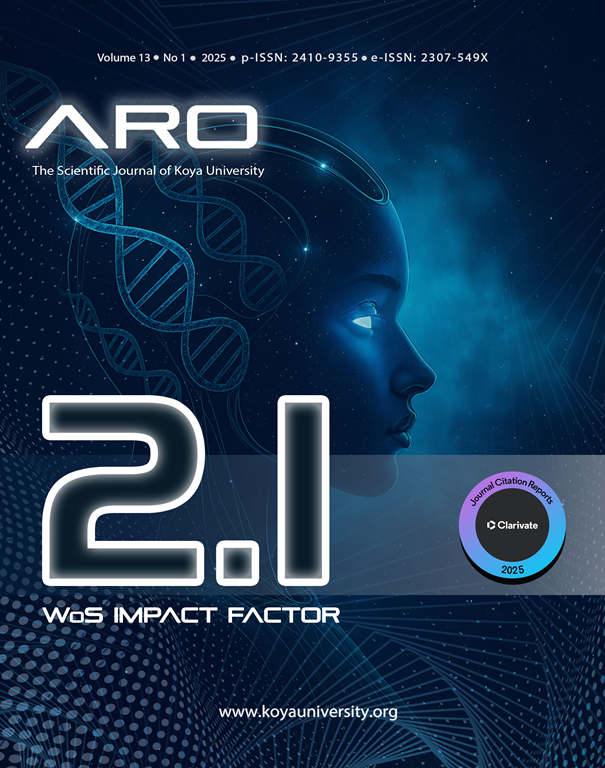The Optimum Sulfur Recovery Process From North Gas Company Sour Acid Gas
A Case Study and Simulation
DOI:
https://doi.org/10.14500/aro.11985Keywords:
Air Pollution, Claus process, Environment protection, Gas sweetening, Gas treatment, Natural gas, Oil and gas industry, Sulfur recoveryAbstract
The North Gas Company in Kirkuk, Iraq produces a sour gas stream that is loaded with considerable amounts of H2S and CO2, at concentrations of 2.95% and 2.54%, respectively. A previous study successfully treated this sour gas stream and produced a sweet gas stream by adopting a natural gas sweetening process using ProMax process simulation software. However, this process also produced an acid gas stream that was loaded with a considerable amount of H2S. The acid gas stream is processed in a sulfur recovery unit to protect the environment. The Claus process is the major technology used to produce elemental sulfur from H2S and SO2 gases. This study examines this process to treat the acid gas stream and recover the elemental sulfur, using ProMax simulation software developed by Bryan Research and Engineering, LLC. Moreover, the simulation model was successful in reducing the amount of H2S from 872.5 kg/h to 60.5 kg/h by adopting two Claus bed reactors to increase the process efficiency. Furthermore, process optimization was also adopted to find out the optimum Claus reactor bed operating temperature at 215°C.
Downloads
References
Abdulrahman, R.K., and Zangana, M.H.S., 2020. The effects of amine type and lean amine temperature on gas sweetening pro-cesses: A case study and simulation. ARO-The Scientific Journal of Koya University, 8(2), pp.78-81. DOI: https://doi.org/10.14500/aro.10738
Afifa, U., Arshad, K., Hussain, N., Ashraf, M., and Saleem, M., 2024. Air pollution and climate change as grand challenges to sustainability. Science of the Total Environment, 928, pp.172370. DOI: https://doi.org/10.1016/j.scitotenv.2024.172370
Alzamzam, W., and Shalhi, A., 2019. Optimization and Modeling of Combustion Air in Sulfur Recovery Unit and Its Effect on Productivity and Environment. Available from: https://engs.sabu.edu.ly/wp-content/uploads/2019/12/CEST02_186.pdf [Last accessed on 2024 Feb 17].
Blázquez, E., Gabriel, D., Baeza, J.A., Guisasola, A., Freguia, S., and Ledezma, P., 2019. Recovery of elemental sulfur with a novel integrated bioelectrochemical system with an electrochemical cell. Science of The Total Environment, 677, pp.175-183. DOI: https://doi.org/10.1016/j.scitotenv.2019.04.406
Hashemi, M., Pourfayaz, F., and Mehrpooya, M., 2019. Energy, exergy, exergoeconomic and sensitivity analyses of modified Claus process in a gas refinery sulfur recovery unit. Journal of Cleaner Production, 220, pp.1071-1087. DOI: https://doi.org/10.1016/j.jclepro.2019.02.213
Ibrahim, S., Rahman, R.K., and Raj, A., 2022. Asplit-flow sulfur recovery process for the destruction of aromatic hydrocarbon contaminants in acid gas. Journal of Natural Gas Science and Engineering, 97, pp.104378-104378. DOI: https://doi.org/10.1016/j.jngse.2021.104378
Saeid, M., Poe, W.A., and Mak, J., 2019. Handbook of Natural Gas Transmission and Processing: Principles and Practices. Gulf Professional Publishing, Cambridge.
Selim, H., Gupta, A.K., and Al Shoaibi, A., 2013. Effect of reaction parameters on the quality of captured sulfur in Claus process. Applied Energy, 104, pp.772-776. DOI: https://doi.org/10.1016/j.apenergy.2012.12.015
Seyed Heydar, R.S., Bastani, K., and Hamidreza, E., 2023. Polymeric membranes for the oxygen en-richment of air in sulfur recovery units: Prevention of catalyst deactivation through BTX reduction. Korean Journal of Chemical Engineering, 40(12), pp.2929-2940.
Seyed, S., Bastani, K., and Eslampanah, H., 2023. Polymeric membranes for the oxygen enrichment of air in sulfur recovery units: Prevention of catalyst deactivation through BTX reduction. Korean Journal of Chemical Engineering, 40, pp.2929-2940. DOI: https://doi.org/10.1007/s11814-023-1487-y
Singh, S., and Raj, A., 2025. Investigating the impact of co-combustion of acid gas and hydrogen in the Claus process for efficient sulfur production, contaminant destruction, and low carbon emissions. Gas Science and Engineering, 134, pp.1-10. DOI: https://doi.org/10.1016/j.jgsce.2024.205535
Taghizadeh, D.A., and Bahadori, F., 2018. A new approach for hydrogen production in Claus sulfur recovery process. Journal of Sulfur Chemistry, 40(2), pp.137-148. DOI: https://doi.org/10.1080/17415993.2018.1545840
Zheng, Z., Lin, Z., Luling, L., Jia, Z., and Qiang, H., 2023. Comparison of oxidation absorption and reduction absorption process for sulfur recovery tail gas treatment of natural gas treatment plants in China Part Ⅰ: Technical section. Journal of the Taiwan Institute of Chemical Engineers, 152, pp.1-10. DOI: https://doi.org/10.1016/j.jtice.2023.105143
Downloads
Published
How to Cite
Issue
Section
License
Copyright (c) 2025 Ribwar K. Abdulrahman, Mohammed H. Zangana, Ganank Srivastava

This work is licensed under a Creative Commons Attribution-NonCommercial-ShareAlike 4.0 International License.
Authors who choose to publish their work with Aro agree to the following terms:
-
Authors retain the copyright to their work and grant the journal the right of first publication. The work is simultaneously licensed under a Creative Commons Attribution License [CC BY-NC-SA 4.0]. This license allows others to share the work with an acknowledgement of the work's authorship and initial publication in this journal.
-
Authors have the freedom to enter into separate agreements for the non-exclusive distribution of the journal's published version of the work. This includes options such as posting it to an institutional repository or publishing it in a book, as long as proper acknowledgement is given to its initial publication in this journal.
-
Authors are encouraged to share and post their work online, including in institutional repositories or on their personal websites, both prior to and during the submission process. This practice can lead to productive exchanges and increase the visibility and citation of the published work.
By agreeing to these terms, authors acknowledge the importance of open access and the benefits it brings to the scholarly community.
Accepted 2025-04-06
Published 2025-04-09
















 ARO Journal is a scientific, peer-reviewed, periodical, and diamond OAJ that has no APC or ASC.
ARO Journal is a scientific, peer-reviewed, periodical, and diamond OAJ that has no APC or ASC.